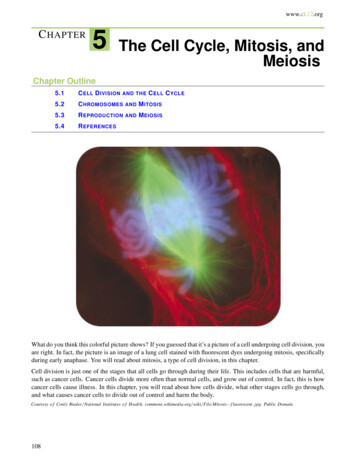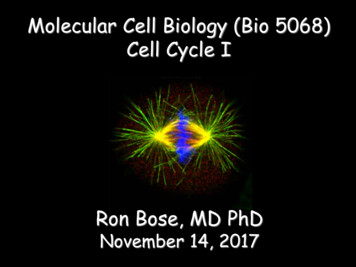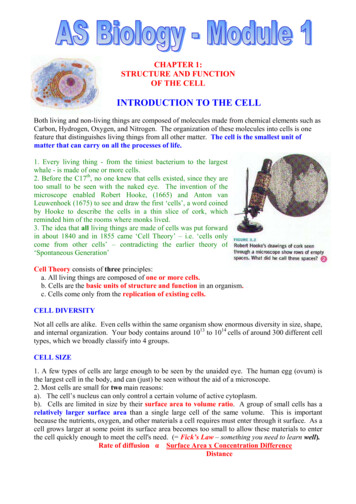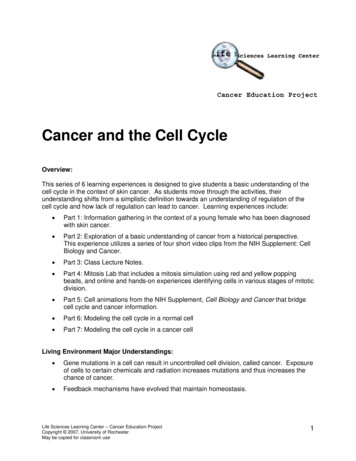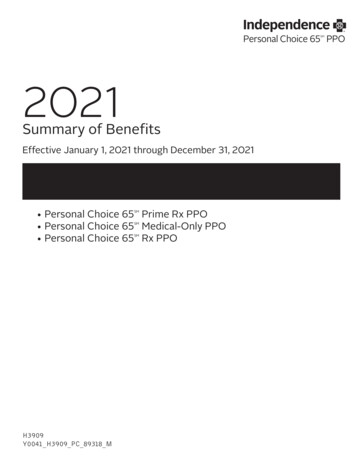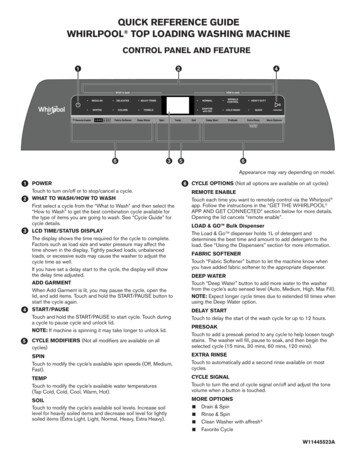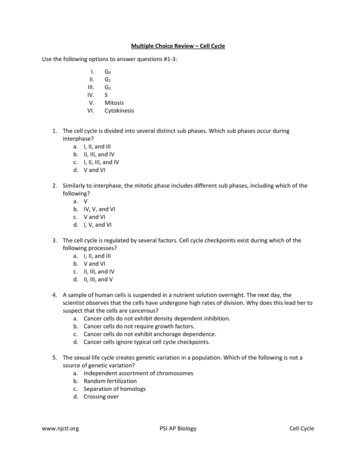
Transcription
Multiple Choice Review – Cell CycleUse the following options to answer questions #1-3:I.II.III.IV.V.VI.G0G1G2SMitosisCytokinesis1. The cell cycle is divided into several distinct sub phases. Which sub phases occur duringinterphase?a. I, II, and IIIb. II, III, and IVc. I, II, III, and IVd. V and VI2. Similarly to interphase, the mitotic phase includes different sub phases, including which of thefollowing?a. Vb. IV, V, and VIc. V and VId. I, V, and VI3. The cell cycle is regulated by several factors. Cell cycle checkpoints exist during which of thefollowing processes?a. I, II, and IIIb. V and VIc. II, III, and IVd. II, III, and V4. A sample of human cells is suspended in a nutrient solution overnight. The next day, thescientist observes that the cells have undergone high rates of division. Why does this lead her tosuspect that the cells are cancerous?a. Cancer cells do not exhibit density dependent inhibition.b. Cancer cells do not require growth factors.c. Cancer cells do not exhibit anchorage dependence.d. Cancer cells ignore typical cell cycle checkpoints.5. The sexual life cycle creates genetic variation in a population. Which of the following is not asource of genetic variation?a. Independent assortment of chromosomesb. Random fertilizationc. Separation of homologsd. Crossing overwww.njctl.orgPSI AP BiologyCell Cycle
6. The image below shows eight Hox genes of the fruit fly. Why is it not surprising that the Antpgene and the Scr gene are located next to each other?Source: ly.svga. Homeobox genes are often organized on the chromosome in the same anteriorposterior order as on the organism.b. Scr and Antp code for structures that are connected so it would be hard to separatethem.c. The bicoid protein ensures that leg genes are always connected to thorax genes.d. Both genes code for the abdomen.7. Cell-based regenerative therapy refers to treating a disease or condition by extractingunspecialized cells and directing them to differentiate into specific types of cells and tissues.What types of cells are required for this type of therapy?a. Stem cellsb. Meristematic cellsc. Mitotic cellsd. Homeotic cells8. The cheetah is a feline native to Africa. It is known as the fastest land animal, able to reachspeeds of up to 75 mph and to accelerate from 0 to 62 mph in just three seconds. On the pictureof the cheetah below, which labeled area refers to the ventral side?ABDCSource: http://commons.wikimedia.org/wiki/File:Gepardjagt2 (Acinonyx jubatus).jpga.b.c.d.www.njctl.orgABCDPSI AP BiologyCell Cycle
9. Metaphase is the stage of mitosis during which the chromosomes line up along the metaphaseplate in preparation of separating into two cells. Several things must occur prior to this stage inorder for mitosis to be successful. Which of the following is not something that occurs beforemetaphase?a. Sister chromatids separate.b. Nuclear envelope fragments.c. Chromosomes become tightly coiled.d. Centrosomes align on opposite sides of the cell.Questions #10-11 refer to the following diagram:Source: http://commons.wikimedia.org/wiki/File:Spindle apparatus.svg10. The diagram shows that each kinetochore has attached to a chromosome. To what part of thechromosome is it attached?a. Centrosomeb. Astersc. Centromered. Cleavage furrow11. The mitotic spindle shown in the diagram arises during the G2 phase, when this structureduplicates.a. DNAb. Centrosomec. Microtubuled. Centromerewww.njctl.orgPSI AP BiologyCell Cycle
12. Crossing over is an event during meiosis that dramatically increases variation in offspring. Thisevent occurs between what structures?a. Chiasmab. Sister chromatidsc. Nonhomologous chromosomesd. Nonsister chromatids13. Two samples of animal cells are attempted to be grown in a laboratory setting. Sample #1 isplaced in a suspension of nutrients while sample #2 spread on a petri dish with the samenutrients. After 24 hours, what type of cell growth will be observed in the samples?a. Sample #1 will show no growth and sample #2 will show a single layer of cells.b. Sample #2 will show no growth and sample #1 will show a single layer of cells.c. Sample #1 will show no growth and sample #2 will show several layers of cells.d. Neither sample will show growth.14. This E. coli cell is undergoing binary fission. Which of the following is not true concerning thisprocess?Source: .It is a type of asexual reproduction.A parent cell becomes two daughter cells.Offspring are genetically unique.It is the method of prokaryotic reproduction.15. Stem cells are of growing interest to scientists and the medical profession. Which of thefollowing is not a characteristic of stem cells?a. Unspecializedb. Able to proliferate indefinitelyc. Can specialize into any cell typed. Grow unchecked to become tumorswww.njctl.orgPSI AP BiologyCell Cycle
Questions #16-17 refer to the following diagram:Source: .png16. The diagram illustrates the process of cytokinesis. To what are the arrows in (1) pointing?a. Mitotic spindleb. Site of fissionc. Cleavage furrowd. Cell plate17. The cells in (2) undergo cytokinesis differently than those in (1). What structure do the cells in(2) use to separate the cytoplasm?a. Asterb. Cell platec. Centromered. Plasma membrane18. The presence of nanos protein in a fruit fly embryo affects the posterior portion of fruit flydevelopment. There are a variety of these types of proteins, all of which establish the anteriorposterior axis of the fly. What category of genes do these proteins fall under?a. Molecular coordinate genesb. Hox genesc. Homeobox genesd. Maternal effect genes19. Fragmentation and budding are two different types of reproduction. Which of the followingstatements correctly compares the two methods?a. Budding requires two organisms while fragmentation requires only one.b. In fragmentation, a new organism is created after a piece separates from the parent. Inbudding, a new organism grows on the parent and then separates.c. Fragmentation is asexual while budding is sexual.d. Budding only produces haploid cells while fragmentation produces diploid cells.www.njctl.orgPSI AP BiologyCell Cycle
20. Meiosis is broken down into two separate processes: meiosis I and meiosis II. Which of thefollowing statements incorrectly pairs an event that occurs in each process?a. Meiosis I: separates homologous chromosomesb. Meiosis II: creates haploid cells with duplicated chromosomesc. Meiosis I: independent assortment along metaphase plated. Meiosis II: separates sister chromatidsQuestions #21-22 refer to the following karyotype.Source: mancsomaldisorders.html21. This karyotype shows Turner’s syndrome in which the individual is missing a sex chromosome.By what other name can this type of defect be called?a. Polyploidyb. Monosomyc. Deletiond. Haploid22. What event would cause Turner’s syndrome?a. The joining of two gametes that are each missing a sex chromosome.b. The joining of a gamete with a somatic cell.c. The joining of a normal gamete with a gamete missing a sex chromosome.d. The joining of two polyploid gametes.23. Gametes and meiosis are related in the same way as which of the following pairs?a. Meiosis: haploidb. Chromosomes: allelesc. Somatic cells: mitosisd. Mitosis: Binary fissionwww.njctl.orgPSI AP BiologyCell Cycle
24. There are a variety of different methods used by organisms to pass on their genes to offspring.Some methods produce genetically identical offspring while others produce unique offspring.Which of the following reproductive methods does not produce clones?a. Sexual reproductionb. Buddingc. Binary fissiond. FragmentationQuestions #25-27 refer to the following image of a sample of cells from a breast lar Mitosis - breast carcinoma.jpg25. The abnormal cell in the middle of the picture is an example of tripolar mitosis. This results fromabnormal mitotic spindles and is evidence that the tumor is malignant. The tumor began whenwhich of the following experienced a mutation?a. Proto-oncogeneb. Promotion factorc. Oncogened. Kinase26. Noncancerous cells undergo a pathway that ultimately ends in apoptosis, programmed celldeath. Cancerous cells, however, do not undergo apoptosis. They also do not follow many otherregulatory processes experienced by other cells. Which of the following is not a growth processignored by cancer cells?a. Anchorage dependenceb. Cell cycle checkpointsc. Interphased. Density dependent inhibition27. While this tumor is deemed malignant, some tumors are localized and do not harm the overallhealth of the organism. What term is used to describe this second type of tumor?a. Cyclin-dependentb. Benignc. Oncogeneticd. Anchorage dependentwww.njctl.orgPSI AP BiologyCell Cycle
28. Kinases are proteins that maintain cell cycle checkpoints. Kinases, however, require thepresence of one other molecule in order to be activated. What molecules is responsible fordoing so?a. Maturation promotion factorb. Cyclinc. Oncogened. Hox gene29. Maternal effect genes work by establishing what inside the embryo?a. Protein gradientsb. Replication patternsc. Nutrient balanced. Differentiation30. Dragonflies are insects capable of flying in six different directions: up, down, forwards,backwards, left, and right. Female dragonflies lay their eggs in or near the water. The babydragonflies, called nymphs, live in the water until they undergo metamorphosis into maturedragonflies. On the picture of the dragonfly below, which labeled area refers to the anteriorside?ABDCSource: fuscatum.jpga.b.c.d.ABCD31. In asexual reproduction, organisms do not have to spend time and energy on finding a mate. Inthis way, asexual reproduction is beneficial over sexual reproduction. Which statement does notdescribe a benefit of asexual reproduction?a. Organisms can reproduce faster.b. All of an organism’s genes are passed to offspring.c. Energy is not spent on creating and maintaining sex cells.d. The population can withstand environmental pressures due to the genetic variation ofthe individuals.www.njctl.orgPSI AP BiologyCell Cycle
32. The cell cycle is a highly regulated process. Which of the following in not something that affectsthe cell cycle?a. S checkpointb. Density-dependent inhibitionc. Growth factorsd. Anchorage dependence33. The picture below shows a mutant fruit fly with two pairs of wings. This occurs when a mutationin the Ubx gene causes that gene to not be expressed. What is the name given to this type ofgene that controls the type of appendage on specific body segments?Source: .c.d.Maternal effect genesStem cellsMolecular coordinate genesHox genes34. Skin cells are placed in a culture containing growth medium. After incubating at 37⁰C for 24hours, the cells have divided to form a single layer that has spread to all borders of the culture.A scientist scrapes away a small circle of cells in the middle of the culture. If she incubates theculture again and returns in 24 hours, what will she find?a. The cells will divide to cover the circle as well as creating a second layer of cells in theother areas of the culture.b. No change.c. The cells will divide, creating a second layer of cells but avoiding the circle of missingcells.d. The cells will divide just enough to cover the circle.Questions #35-40 refer to the following scenario:A scientist is working with a unique cell sample. He isolates two molecules that are always present whenthe cells divide. To determine the effects of the two molecules, he sets up the following experiment. Ingroup #1, he spreads cell samples on a petri dish and adds molecule A. In group #2, he spreads cellsamples on a petri dish and adds molecule B. In group #3, he spreads cell samples on a petri dish andadds molecules A and B. In group #4, he spreads cells samples on a petri dish with no added molecules.He uses a sample size of five. The results are shown in the table below.www.njctl.orgPSI AP BiologyCell Cycle
Cellular growthTreatment #1Treatment #2Treatment #3Treatment #4No growthXXXX35. What would be the null hypothesis for this experiment?a. Molecules A and B are necessary for cellular growth.b. Molecule B affects cellular growth while molecule A does not.c. Molecules A and B have no effect on cellular growth.d. Molecule A affects cellular growth while molecule B does not.36. Explain the results.a. Molecules A and B are both growth factors for the cell.b. Molecule A is a cell cycle checkpoint for molecule B.c. Molecules A and B are enzymes that speed up the mitotic phase.d. Molecule B is a metastasized version of molecule A.37. What would have to change about treatment #1 in order to cultivate cellular growth?a. Add more molecule A.b. Add molecule B.c. Incubate at a higher temperature.d. Take away molecule A.38. Which of the following is not a variable that should have been controlled in the experiment?a. Volume of molecule A/B addedb. Temperature of petri dishesc. Alternating periods of light and darknessd. Duration of incubation39. How many petri dishes are used in this experiment?a. 4b. 5c. 15d. 2040. Which group is the control group?a. Treatment #1b. Treatment #2c. Treatment #3d. Treatment #4www.njctl.orgPSI AP BiologyCell Cycle
Quantitative Review – Cell Cycle1. The fruit fly has eight chromosomes. During the S phase of interphase, thesechromosomes are duplicated. How many chromatids are present after the S phase in afruit fly?2. The common house cat is a diploid animal with 38 chromosomes. How many chromosomes arepresent in the gametes of a house cat?3. Independent assortment leads to genetic diversity in offspring. When chromosomes assortindependently, there are 2n ways for them to line up along the metaphase plate (n # ofchromosomes). In a rabbit, a diploid animal with 44 chromosomes, how many different wayscan the chromosomes line up during meiosis?4. In a controlled laboratory setting, 14 somatic cells are prompted to undergo meiosis. How manycells will be present at the end of meiosis II?5. Chinchillas are rodents that are native to the Andes Mountains in South America. Although theyhave become popular as household pets in the United States, they have specific requirementsthat can make them difficult to care for. Because of this, chinchillas are often found in animalshelters across the country. After interphase in a chinchilla, 128 chromatids are present. Howmany chromosomes do chinchillas have?6. The sea star is an echinoderm found in marine environments. If there are 6.9 x 1010 ways for thechromosomes of a sea star to line up along the metaphase plate during meiosis, how manychromosomes does a sea star have?www.njctl.orgPSI AP BiologyCell Cycle
ANSWER orgPSI AP 9.40.ACBBABDADDCABCDD1.2.3.4.5.6.16191.8 x 1013566436Cell Cycle
Scr and Antp code for structures that are connected so it would be hard to separate them. c. The bicoid protein ensures that leg genes are always connected to thorax genes. . d. Mitosis: Binary fission . www.njctl.org PSI AP Biology Cell Cycle 24. There are a variety of different methods used by organisms to pass on their genes to offspring.

